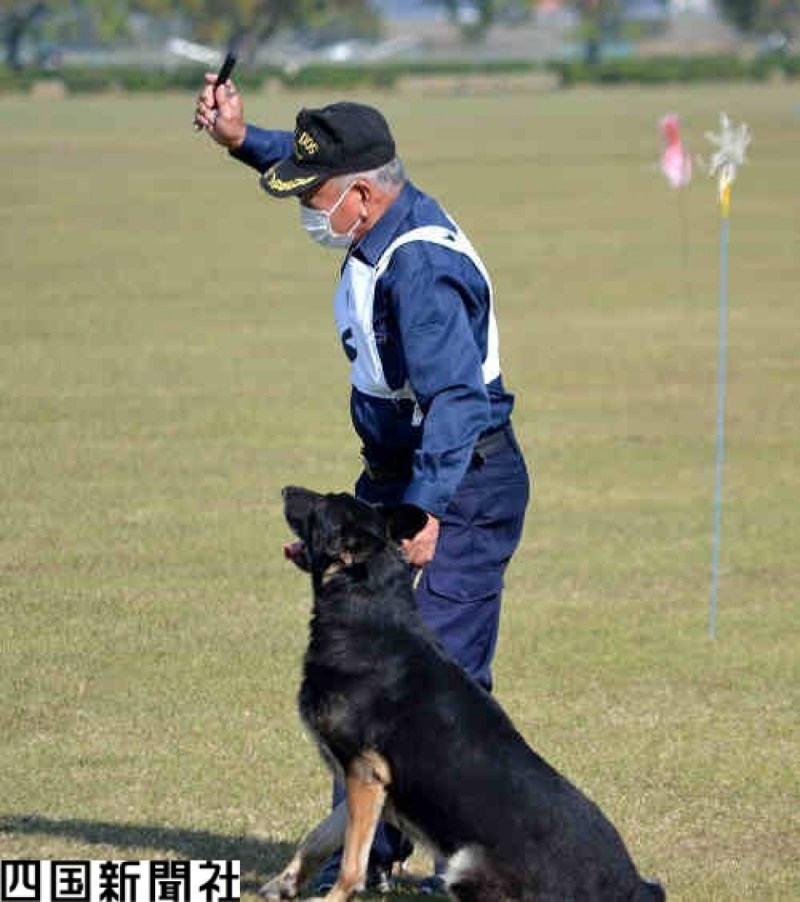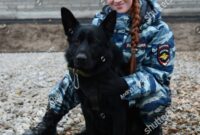Police Dog Training – It is a dog trained to assist police and other law enforcement officers. Their duties may include searching for drugs and explosives, finding missing persons, finding evidence of crimes, protecting officers and other people, and attacking suspects fleeing from officers. The breeds most commonly used by law enforcement are the German Shepherd, Belgian Malinois, Police Dog, Dutch Shepherd, and Labrador Retriever.
Over the years, Belgian Malinois have become the top choice for police and military work, and because of their instinctive drive, focus, agility, and size, the German Shepherd remains the breed most closely associated with law enforcement.
Police Dog Training

In many parts of the world, police dogs are used at both the federal and local levels for law enforcement purposes. They are often assigned to a special handler, called a K-9 unit in some countries, and must memorize a number of verbal cues and hand gestures.
Police Dog Life, Training Stories
Initial training for a police dog usually takes between eight months and a year, depending on where and how it is trained and for what purpose. Police dogs take regular training sessions with a designated handler to enhance their training.
Dogs have been used in law enforcement since the Middle Ages. Tithes of wealth and money were paid into the villages to maintain the bloodthirsty parish police who were used to hunt down outlaws.
The first recorded use of police dogs dates back to the early 14th century in Saint-Malo, France, where they were used to guard docks and docks.
By the end of the 14th century, bloodhounds were being used in Scotland as “slow dogs” – from which the word “detective” (meaning detective) is derived.
Pune District To Get Cutting Edge Police Dog Training Center: A Game Changer For Law Enforcement
Between the 12th and 20th centuries, bloodhounds were used in the British Isles and continental Europe primarily for their tracking abilities.
In London, the Bow Street Runners, an existing legal force, struggled to control crime on their own, and as a result, private associations were formed to help fight crime.
Night guards were appointed to guard the building and were provided with guns and dogs to protect themselves from criminals.

The bloodhounds used by Sir Charles Warr to track down serial killer Jack the Ripper in the 1880s.
Police K9 Dog Training Belgian Malinois Stock Photo 1454868698
A German Shepherd Dog used by a Schutzpolizei police officer and a SA during the German federal elections in March 1933, shortly after the Nazis seized power
One of the first attempts to use dogs in policing was in 1889 by Sir Charles Warr, Commissioner of the Metropolitan Police in London. Warren’s repeated failure to identify and catch serial killer Jack the Ripper earned him much infamy in the press, including discredit for not using bloodhounds to track down the killer. He immediately trained two police dogs to perform a simple tracking test for another of the killer’s crimes. The results were not satisfactory, as one of the hounds bit the commissioner, and then the two dogs escaped, which required the police to search for them.
Dogs were first widely used in continental Europe. Police in Paris began using dogs against night-roaming criminal gangs, but the first organized police service dog program was introduced in 1899 by the police department in August, Belgium.
These practices soon spread to Austria-Hungary and Germany; Later, the first scientific developments in this field came through experiments in raising and training dogs. The German police chose the German Shepherd Dog as the ideal breed for police work, and in 1920 opened the first dog training school in Greheide.
Full Body Protection Bite Suit Police Dog Training Jacket +pant Schutzhund L Xl
In later years, several Belgian Malinois were added to the unit. The dogs were systematically trained to obey their officers and track and attack criminals.
In Britain, the North Eastern Railway Police were among the first to use sniffer dogs to prevent theft from Hull’s docks in 1908. By 1910, railway police forces were experimenting with breeds such as the Belgian Malinois, Labrador Retrievers, and German Shepherds.
Common dog breeds used by law enforcement include: Airedale terrier, Akita, Grodael, Tervuer, Malinois dog, Bernese Mountain Dog, Bloodhound, Border Collie, Boxer, Bouvier des Flandres, Briard, Cane Corso, Bullmastiff, Doberman Sheepdog, Doberman Sheepdog, Doberman. Sheepdog, Shepherd Dog, German Shorthaired Pointer, Golden Retriever, Labrador Retriever, Rottweiler and German Springer Spaniel, Dogo Argentino.

Training police dogs is a long process that begins with training the trainers. Dog handlers go through a long training process to ensure that the dog is trained to the best of its ability. First, a dog handler must complete the required police academy training and one to two years of patrol experience before being eligible to move to a specialized canine unit.
Police Dogs In Training Hi Res Stock Photography And Images
Because experience as an officer allows potential canine officers to gain valuable law enforcement experience. However, dog knowledge and training is an asset outside of the police academy, which can include dog obedience, crowd control, effective communication with animals, and being friendly and personable, as the presence of a dog can attract the attention of surrounding citizens.
In order for a dog to be accepted into the police department, it must first pass a basic obedience training course. They must be able to obey their handlers’ commands without hesitation.
This allows the officer to have full control over the amount of force the dog can use against the suspect. Dogs trained in Europe usually give commands in the country’s native language. Dogs are first trained in this language for basic behavior, so it is easier for the officer to learn new words/commands rather than having to retrain the dog to new commands. This goes against the common belief that police dogs are trained in a different language so that the suspect cannot command the dog against the officer.
Dogs used in law enforcement are trained as either “single-purpose” or “dual-purpose.” Single-purpose dogs are primarily used for backup, personal protection, and tracking. However, dual-purpose dogs are more common. Dual-purpose dogs do everything single-purpose dogs do, plus detect explosives or drugs. Only one or more dogs can be trained because the dog cannot communicate with the officer if explosives or drugs are detected. If a drug dog in the United States signals to an officer that it has found something, in most states the officer has probable cause to search whatever the dog alerts to (for example, a bag or vehicle) without a warrant.
Dog Training Archives
In case of suspicious fear, it is useful to have a dog that barks loudly and can surrender without delay in suspicious situations.
The examples and viewpoints presented in this section do not represent a global view of the topic. You can improve this section, discuss the issue on the talk page, or create a new section as appropriate. (January 2022) (Learn how and how to remove this message)
Police dogs are retired if they are injured to the point that they have not fully recovered, are pregnant or nursing a puppy, or are too old or ill to continue working. The working life of a dog ranges from 6 to 9 years, with many dogs being bred for the first year of their lives in work yards and then retired before they are no longer able to perform.

However, in some countries, when police dogs are retired, they may have the opportunity to obtain an optional plan for their contribution to the police. In 2013, the Pawn Scheme for sniffer dogs was introduced in Nottinghamshire, with the police force pledging £805 over three years to cover additional medical costs; The dogs were also allowed to be adopted by their original trainers.
Massachusetts Police Work Dog Association
In many countries, police dogs killed in the line of duty are given the same honors as their human counterparts.
The examples and viewpoints presented in this section do not represent a global view of the topic. You can improve this section, discuss the issue on the talk page, or create a new section as appropriate. (April 2023) (Learn how and how to remove this message)
A 2020 investigation coordinated by the Marshall Project found evidence of the widespread deployment of police dogs in the United States as a force disproportionately and disproportionately against people of color. A series of 13 linked reports from 2015 to 2020 found more than 150 instances of K-9 officers using dogs as weapons to grab, bite and injure people.
The rate of police K-9 bites in Baton Rouge, Louisiana, which has 220,000 black residents, is more than double that of the next-place city of Indianapolis, with about a third as many police dog bites. Those affected by Teague are mostly black. Medical researchers have found that police dog attacks “are more similar to shark attacks than family pet bites” due to their aggressive training. Many people have never been bitten and are not suspected of crimes. Police officers are often shielded from liability, and federal civil rights laws generally do not cover bystanders who are accidentally bitten. Victims can file a lawsuit, advocates say, and they’re fighting because jurors love police dogs. In Singapore, dogs have played an important role in police work.
Man’s Best Friend
Police academy dog training, k 9 police dog training, police dog training schools, police dog training near me, police dog training jobs, police dog training courses, police dog training equipment, k9 police dog training, german shepherd police dog training, police dog training for civilians, dog training for police, police dog training cost
- Search Rescue Dogs - July 29, 2024
- Police Dog Training - July 25, 2024
- Pointing Dog Training - July 25, 2024




